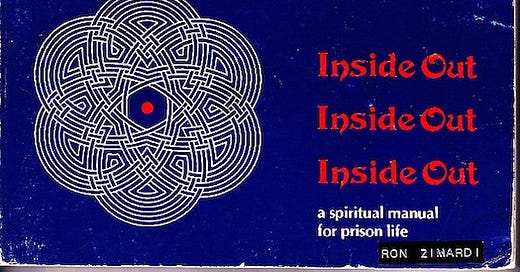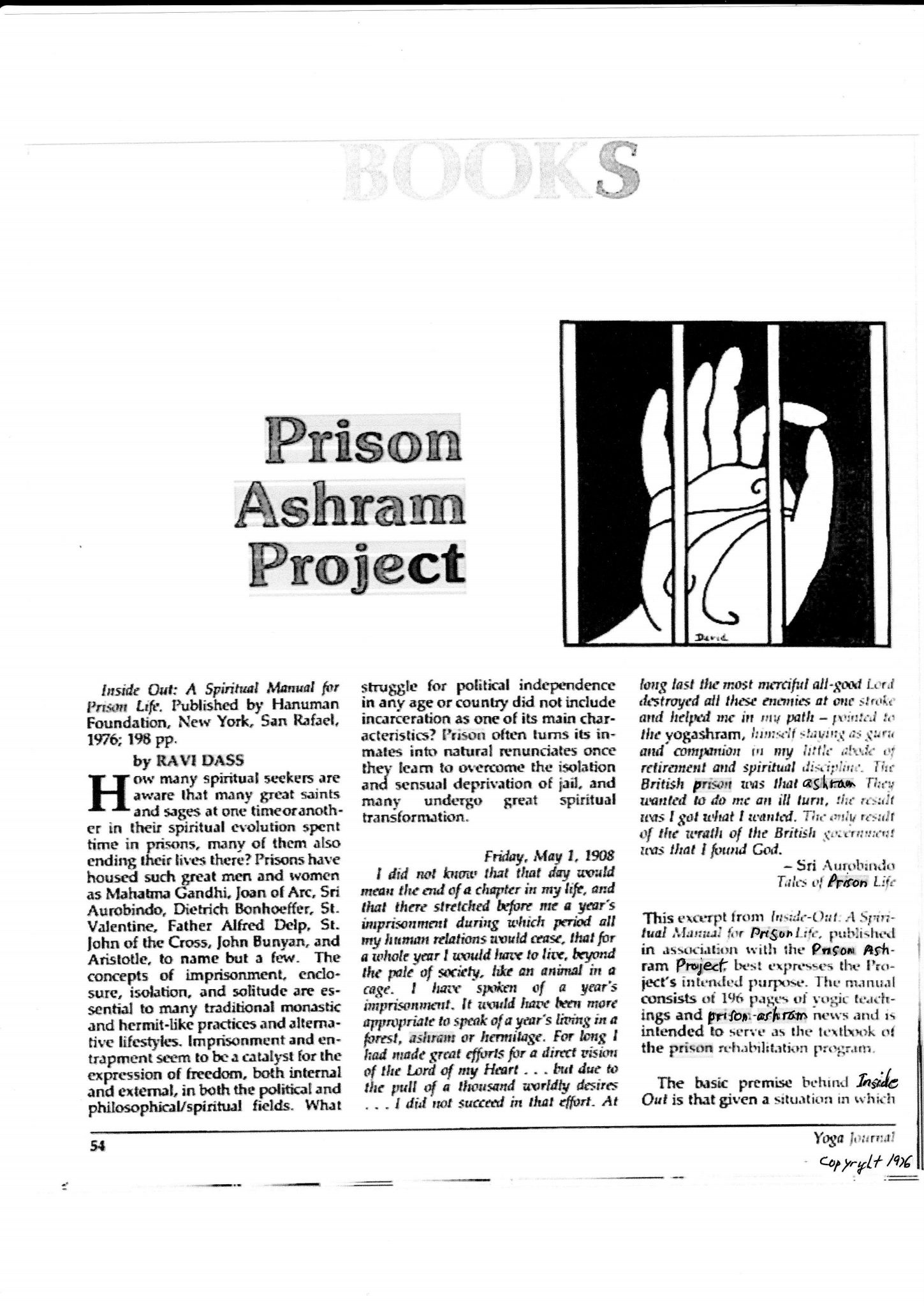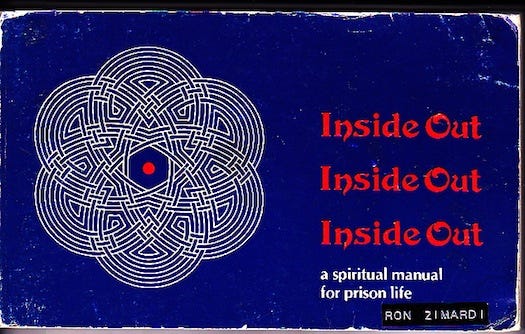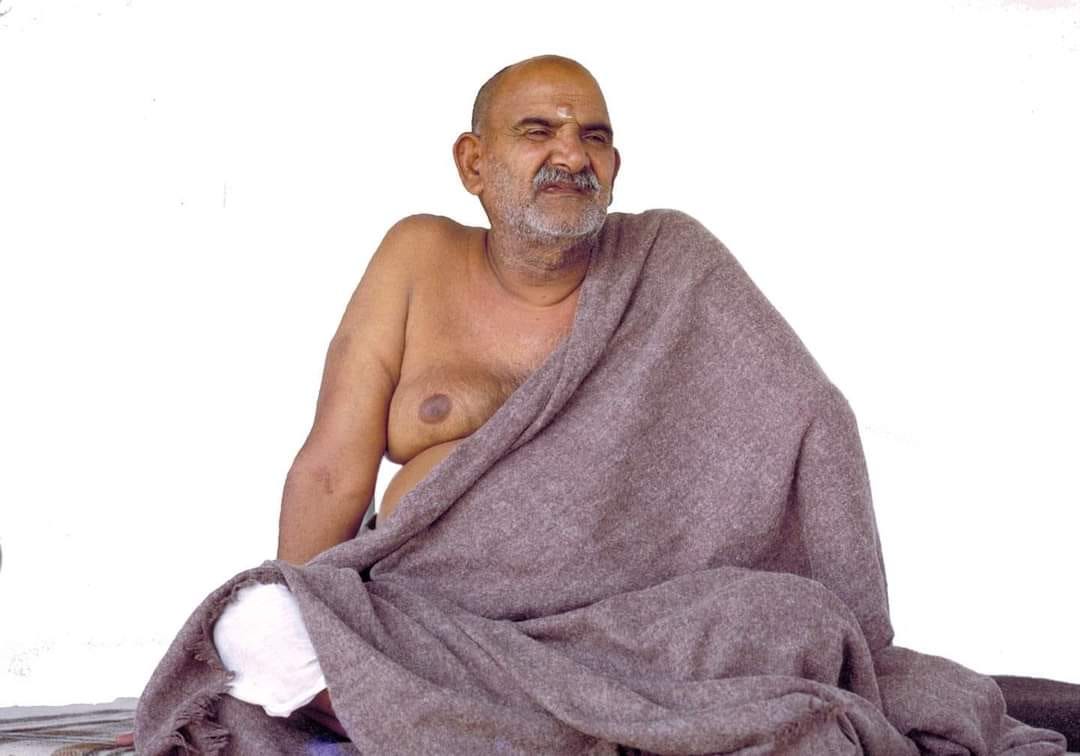'Inside Out'... A spiritual manual.
The only guidance you need to succeed in spiritual life. Published by Ram Dass.
I don’t remember writing this article reviewing Inside Out. I’m impressed at whoever wrote it. It’s not exactly my current philosophy, but close enough. I was a Western Philosophy major in college and a spiritual seeker forever since then in one way or another, as the manual says, either inside-out or outside-in. We are all prisoners of some sort. Prisoners of our mind, prisoners here on Earth serving our time, prisoners of our body, our mortality. This book reminds me of reading the teachings of Shivapuri Baba in ‘The Long Pilgrimage’, all I kept thinking was, ‘are you kidding, no one can do this’.
Inside Out is jammed packed with more than enough practices and exercises to get you ahead of the game. Remember I told you to forget that garbage about everybody getting enlightenment like getting ice cream. Just try to get a clear mind so you can get guidance from God or your ‘real’ guru. Enjoy the wheel, don’t fight it. It’s taken me 60 years to get where I am and I don’t wish my path on anyone, I won’t be telling you to follow me at all, you’d be dead right after you started. What do you think of me living with HCV since 1964. Some advanced person in Goa told me not to get cured, it was a good part of my story. I doubt any of you could live with HCV for 60 years. Sivaya is already dead as an example. And the other times I was almost killed you wouldn’t want to experience. Remember Maharaji told me to live like a bird, that’s hard enough. Today I have $100 to my name in Thailand. To the neighbors, they think I am a rich American.
This is the only book that gives you a hatha yoga course in it. Of course I know there are a hundred YouTube yoga courses and every sort of ridiculous Internet meditation app. But you won’t get far, I bootstrapped all of my sadhana. Not in some penthouse. Sleeping with bedbugs, having no money in India or the USA, eating minimal for years, going on 3rd class Indian filthy trains, sleeping in caves, almost freezing to death in Kedarnath, losing hundreds of thousand of dollars due to horrible mistakes and maybe innocently aiding the death of others. It’s like Jesus taking on all of the sins back then (don’t ask me why), I have taken on your ‘redemption’, and don’t call it karma. Maybe the message is don’t do what I did. Both Ram Dass and I have fallen in love with fake and misguided and sometimes evil gurus. They can all look like 99% perfect but it’s the 1% of ‘evil’ that will get you thrown backwards years. Only trust the Virgin Mary, 100% kosher, make no mistake about it. She is the Mother of God. Whoever you think is your guru, Hindu, Tibetan or American is nothing but a stranger in the universe. I once went really early to an Adyashanti talk and when he came out and sat high up on stage in a formal upholstered chair, I said ‘forget about’it’, never again. And Bubba Free John, Franklin Jones, whatever, met me in Los Angeles at his ‘temple’ when I returned from India (we were friends at Muktananda’s) and I walked in and he was sitting on some kind of throne, we talked a bit, and I said ‘forget about’it’, never again. Maharaji sat on a wooden ‘tucket’, bed, and wore a plaid blanket. Whatever you gave him he threw back into the crowd, especially apples. No one knows who he was, he was too far out to see his place near God. Labels don’t mean anything my friends, just guesses. Anyway here is a free copy again of Inside Out. That’s the last free thing you are getting from me (details later). I hope I have destroyed all your spiritual misconceptions which are many and left you reeling. Remember, charity.
Original review article written by Ravi Dass
The book:
Sample of article, pg. 1.
Easier to read article from Yoga Journal: (I spent a whole day typing this, I hope you appreciate it.)
Yoga Journal © 1976
Books July/August 1977
Prison Ashram Project
Inside Out: A Spiritual Manual for Prison Life: Published by Hanuman Foundation, Ram Dass, New York, San Rafael, 1976; 198 pp.
by RAVI DASS
How many spiritual seekers are aware that many great saints and sages at one time or another in their spiritual evolution spent time in prisons, many of them also ending their lives there? Prisons have housed such great men and women as Mahatma Gandhi, Joan of Arc, Sri Aurobindo, Dietrich Bonhoeffer, St. Valentine, Father Alfred Delp, St. John of the Cross, John Bunyan, and Aristotle to name but a few. The concepts of imprisonment, enclosure, isolation, and solitude are essential to many traditional monastic and hermit-like practices and alternative lifestyles. Imprisonment and entrapment seem to be a catalyst for the expression of freedom, both internal and external, in both the political and philosophical/spiritual fields. What struggle for political independence in any age or country did not include incarceration as one of its main characteristics? Prison often turns its inmates into natural renunciates once they learn to overcome the isolation and sensual deprivation of jail and many undergo great spiritual transformation.
Friday, May 1, 1908
I did not know that that day would mean the end of a chapter in my life, and that there stretched before me a year’s imprisonment during which period all my human relations would cease, that for a whole year I would have to live, beyond the pale of society, like an animal in a cage. I have spoken of a year’s imprisonment. It would have been more appropriate to speak of a year’s living in a forest, ashram or hermitage. For long I had made great efforts for a direct vision of the Lord of my Heart…but due to the pull of a thousand worldly desires…I did not succeed in that effort. At long last the most merciful all-good Lord destroyed all these enemies at one stroke and helped me in my path - pointed to the yoga ashram, himself staying as guru and companion in my little abode of retirement and spiritual discipline. The British prison was that ashram. They wanted to do me an ill turn, the result was I got what i wanted. The only result of the wrath of the British government was that I found God.
-Sri Aurobindo
Tales of Prison Life
This excerpt from Inside Out, A Spiritual Manual for Prison Life, published in association with the Prison-Ashram project best expresses the Project’s intended purpose. The manual consists of 196 pages of yogic teachings and prison ashram news and is intended to serve as the textbook of the prison rehabilitation program.
The basic premise behind Inside Out is that given a situation in which a human being is specifically put into a monastic setup, one of whose primary functions is rehabilitation as well as incarceration, what better opportunity could there be for a conscious effort toward spiritual transformation and consciousness raising. Given that mobility is near zero, room and board are free, and everything necessary for basic survival is supplied, there’s plenty of time and space for meditation, Hatha yoga and self improvement.
At present there is no such thing as a successful bureaucratically run prison rehabilitation program. As far as our contacts and letters indicate, the prison-yoga ashram programs - run by non-bureaucratic prison yoga units (the prison satsangs) or outside affiliated yoga groups - seem to promote increased spiritual self-awareness among participating inmates.
Yoga and its related systems have yet to be used formally by the various local and federal level prison administrations. That the time has come to introduce yoga/meditation programs in the prison system can be seen by glancing through the letters section of Inside Out. The numbers of inmates requesting books, tapes, and correspondence seem to indicate a genuine readiness for inner awakening.
Inside Out was compiled in accordance with the prisoners stated needs. The material was designed to be specifically applicable to people in prison and to fit a format embodying Eastern disciplines within a Western scientific framework. It was also designed so that both beginning and advance students could find their levels within the expansive yoga system presented. Those who join the program are clearly at different stages of the inner journey. Many inmates are beginners, confused as to what an inner journey or spiritual work is all about. Others in prison are well along in this journey of transformation and require more advanced techniques. Inside Out tries to fulfill the needs of both groups and of those in between. The techniques are described simply and directly. The inmates own knowledge of who they are and where they are on the wheel of life, of samsara, determines what practices they choose. This selection is an important exercise in itself. There are no wrong decisions in this endless time/space game. Ironically, the predicament inmates face is actually no different from that confronting those supposedly “free” on the outside. The insights of Inside Out are equally valid for all human suffering everywhere, for who is free from ignorance and illusion and the process of birth, aging, disease, and death?
The focus of the manual is based, in large part, on input from inmates themselves. Solitude and isolation generally dictate self-development as a natural mode of unfoldment. “The guru is within” could be considered the mantra of Inside Out. The three levels on which the process operated can be described as: inside out, outside in, and neither inside nor out - in that progression. These phases can be likened to form, formlessness, and neither form nor formlessness. In the beginning, inmates tend to aspire to freeing their consciousness from within in order to join in the cosmic spiritual dance of society - outwardly. This is the natural tendency for anyone starting on the spiritual path. Though prisoners are bound by four solid walls, they can experience an interconnectedness with the outside world. This is the role and function of prison yoga classes, and satsangs, spiritual books, tapes, and letters. This stage, one of joining and belonging on the physical plane, can alleviate much of the isolation of prison. In the next step, prisoners take all the teachings and meditative practices, and direct their energies within to seek the core of being and the meaning of existence - the answer to the question, ‘Who am I?’ Once they have trod this path for some time, the outside-in phase, a balance or synthesis is inevitable within the cosmic mandala of form and emptiness. The mandala - actually one continuous strand though it seemed to be dualistic, weaving in and out, in and out - becomes the third stage, which is not the third really, but the union of form and emptiness; no beginning and no end, no inside or out - crystal clear awareness. So Inside Out symbolizes the inmate’s journey through time and space, the source where everything dissolves into the fullness of the Void.
The stress in Inside Out is not on finding or searching externally for a guru or teacher, but on turning within and utilizing the tools and simple techniques provided in the Inside Out sadhana. This would lead to true self-realization, one that illuminates the relationship between Self, God, and Dharma, in that the Truth is within one and one within it. All distinction and separation dissolve.
The primary aim of prison-ashram yoga is to help prisoners connect with the cosmic flow, the Tao realization: to come to a balance within the universal harmony. The first step in this sadhana is realizing where one is and who one is. Actually, there is no better place on earth for yoga than a six-by-eight cell.
Prisoners have a choice: they can waste the next ten years - or the rest of this precious human life - in guilt, self-pity, and depression, drowning it in drugs and alcohol, or they can do the practices to tune the mind into the flow, into harmony and peace, doing Hatha yoga or tai chi to get the body together. The choice is up to them. This is why the manual is not forced on the inmates or indiscriminately handed out. If they want a copy, they have to request it, thus taking the first step on a long journey. This is the acknowledgement of their karmic predicament.
Over the past year, since the first issue of Inside Out appeared, scores of new yoga/meditation groups have been forming across the country in prisons, jails, halfway houses, drug abuse programs, and mental hospitals. There are now hundreds of yoga classes being held in prisons around the country. The Project is in touch with several thousand inmates and staff members in over three hundred and fifty correctional facilities in the USA, as well as sixteen facilities abroad. This article, it is hoped, will provide additional impetus for an already speedily evolving system.
The Inside-Out system is not encouraging visions of blue light realms or golden angels or eternal bliss or four foot high levitations; rather, it uses inmates and staff alike to go beyond that kindergarten approach to spirituality and develop that most elusive of all qualities: a calm, clear mind tuned totally and constantly into the here and now - complete mindfulness, complete love, complete realization.
The following poem by Han Shan, a Chinese Buddhist sage, the frontispiece of Inside Out, illustrates the manual’s grounded approach.
The clear water sparkles like crystal,
You can see through it easily, right to the bottom,
My mind is free from every thought,
Nothing in the myriad realms can move it,
Since it cannot be wantonly roused,
Forever and forever it will stay unchanged,
When you have learned to know in this way,
You will know there is no inside or out!
-Han Shan
Inside Out includes material that the Foundation staff has found personally useful in their own inner work over the past dozen years. It honors any method that brings seekers close to reality, as long as by practicing that method they do not limit other beings from also attaining realization by their methods. The practices are not intended to constitute a new religion or conflict with those gently practiced by inmates or administration. Drawing on Buddhist, Christian, Moslem, Jewish, and Hindu sources, the practices derive from that which exists in every religion, the teaching of the living spirit. They are meant to help individuals to know God or Truth, to live in God, and even to become God.
Included in the book are techniques that work with the body, mind and daily situations, and especially problems peculiar to prisons such as violence, homosexuality, drugs and depression. The Hatha yoga section presents a complete pictorial exercise course designed to cleanse the nervous and psychic systems and improve the ability to sit in meditation. For opening the heart and working with the flow of forms in the universe, there are prayers, poems, reflections, visualizations, stories, letters, and photos to take the inmates inside gently, by expanding their capabilities of love and compassion, especially in regard to themselves. The practices are designed so inmates can share the grace of their own awakening and find their own humanity at the center of the heart, which may be called Christ-consciousness. This material has come through Yellow Lark, Walt Whitman, Gandhi, Maharaji Neem Karoli Baba, Swami Muktananda, Soma Krishna, Swami Kriyananda, Swami Satchidananda, Father Ed, St. John of the Cross, the Hasidic masters, St. Valentine, and many others.
For mind control there are lines of teachings. First, article, lectures, and interviews by Ram Dass, David Graves, Ravi Dass, and others, which give an understanding of the various ways of thinking about the process and possibilities of awakening; and second, a number of specific meditation practices provided by Joseph Goldstein, Dan Goleman, Ram Dass, Ramana Maharshi, and Soma Krishna, which teach how to gain control over the mind process and to flow into the space beyond thought. This meditation section receives the heaviest emphasis since the Hanuman Foundation feels that the practice of meditation, self-exploration, is the basis of the spiritual quest.








Can you please re-upload the whole booklet? The link has expired! Thank you! Ram Ram 🙏